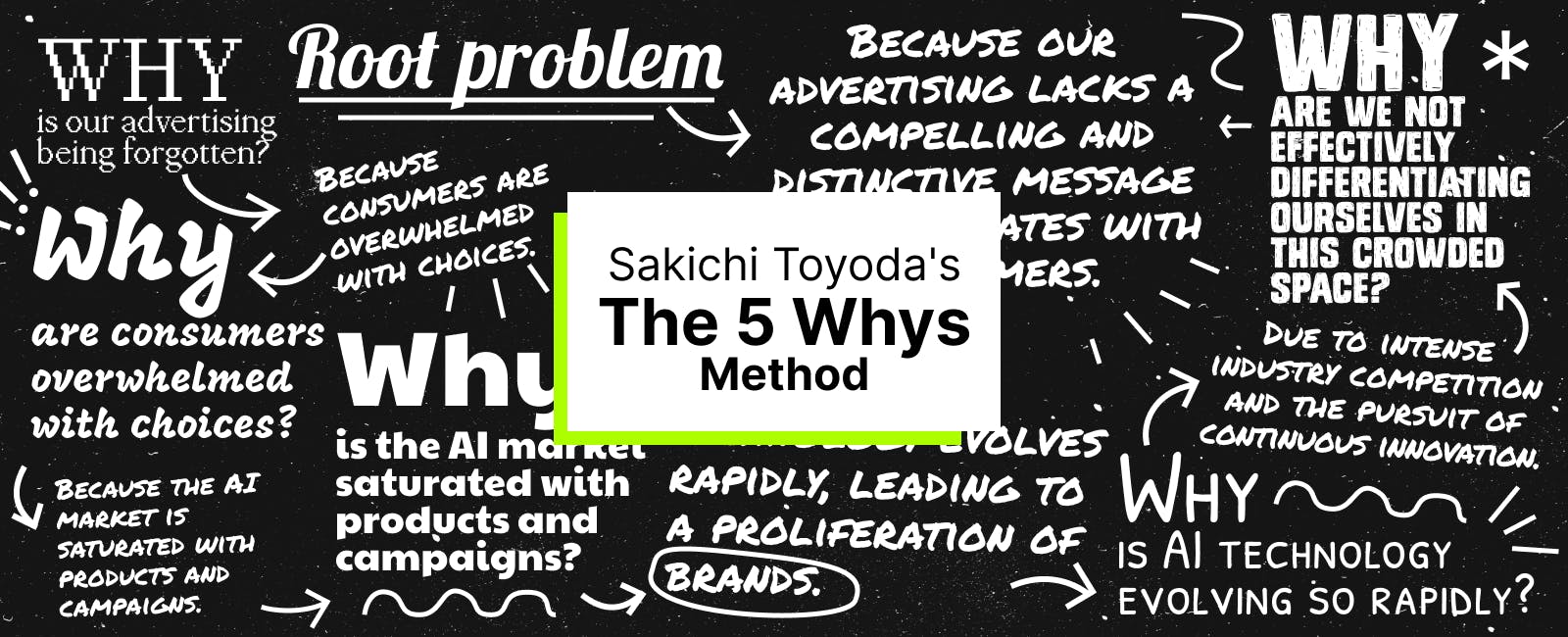
Sakichi Toyoda's "The Five Whys"
November 15, 2023
Picture this: Sakichi Toyada, one of the founding fathers of the Japanese industrial revolution and often referred to as the “King of Japanese Inventors,” sitting at his desk, desperately trying to find the solution to his businesses problem. He’s on the brink of bringing Toyota Motor Corporation to massive expansion. But when hit with inevitable problems in business, he asked himself why? Except he did it five times. Birthing the Five Whys, an iterative technique used to explore the cause and effect of a consumer and business problem.
When discussing the Five Whys with my team, one of my co-workers said something funny (shoutout Tam): “I like this! Reminds me of a kid who asks ‘but why?’ A million times a day” - spot on, I thought. Annoying? Sure. Effective? Probably. The idea of this framework (if you want to call it that) is all about digging deep, peeling back the layers of a situation or problem until you crack the root cause.
Example
- Why is our advertising being forgotten? - Because consumers are overwhelmed with choices.
- Why are consumers overwhelmed with choices? - Because the AI market is saturated with products and campaigns.
- Why is the AI market saturated with products and campaigns? - Because AI technology evolves rapidly, leading to a proliferation of brands.
- Why is AI technology evolving so rapidly? - Due to intense industry competition and the pursuit of continuous innovation.
Why are we not effectively differentiating ourselves in this crowded space? - Because our advertising lacks a compelling and distinctive message that resonates with consumers. <—-ROOT PROBLEM.
All of that said, how can a strategist leverage it? It’s been said that the creative is in charge of advocating for the idea, accounts for the client, and the strategist for the consumer. What better way to resonate with your target consumer than recognizing and speaking to their problem? The best way to advocate for the consumer is to get into their experience and empathize with their problem. Strategists rely on studies, surveys, and focus groups, and they should, but, sometimes the only way to get to the core of a problem is to be incredibly curious.
Take this excerpt from Robert S. Feldman: “Most participants initially asserted that they had been entirely truthful during their conversation. In fact, though, 60 percent had distorted the truth at least once during those ten minutes — most of them without even realizing it.” Without innate curiosity or a framework that digs deep, how do you sift through the “truth”. This is what I think is the first use case for this framework as a strategist: Cutting through the noise of surface level answers. One of the main goals of a strategist is to find the personal or human quirk and present it in a novel way – that’s essentially what an insight is (a topic for a different day). With that said, you can’t rely on consumers to be completely truthful when doing your research, rather, use it as a starting point and then dig deeper - 5 times deeper. The second use case for this framework is for brainstorming sessions, give the Five Whys a shot when you and your co-worker are trying to nail down the consumer and/or business problem. What it will get you to do is cut through the fog of assumption and help reveal the (one of many) true statements for these components of a brief. Still, all of that said, it’s just a framework, and most of the time frameworks are not the end, but the means towards an end. Which leads us to a few potential pitfalls of the five whys.
Now, I am all for this framework as something to pull out when a strategist may be stumped. But, I did find some convincing arguments as to why this framework should be used but not relied upon. In fact, the criticism is from Teruyuki Minoura, former managing director of Global Purchasing for Toyota. Here are a few reasons for his criticism: “Inability to go beyond the investigator's current knowledge – the investigator cannot find causes that they do not already know.” This critique is interesting because it calls out the strategist/investigator’s knowledge or lack thereof. It showcases that although a strategist may think they know all the answers, they only know truths based on the research they’ve done – which can be narrow or cherry picked itself. The other critique that stood out was “results are not repeatable – different people using five whys come up with different causes for the same problem.” Now I understand the sentiment of this critique but I’m going to push back a little bit. I can see how this inherently is not a good thing from an investigational/scientific lens but, I don’t necessarily see that as a problem when creatively problem solving. I say that because a lot of the time, sound problem identification thrives when one avoids tunnel vision and if the Five whys gives a wide range of different perspectives is this a negative or positive? In math or science the variability in answers will prove to be an issue, but in advertising, I think the different perspectives are key to driving exceptional insights.
There we have it, a high level look into Sakichi’s Toyoda’s Five Whys. Leveraging this technique for different consumer and business problems can help unearth a root cause of any issue. Give this framework a shot in your agency jam sessions and witness transformation first-hand.
We'd love to hear about your experiences and insights about the blog and this method. Are you as high on it as we are? If not, why? Visit our post on LinkedIn and let’s get a conversation going – we're always here to exchange ideas and learn together.
